2013-12-08 Created By BaoXinjian
一、摘要
ADADMIN是用于Oracle APPS文件系统和数据库的维护工作,是APPS DBA常用的工具。
AD Administration Main Menu
1.Generate Applications Files menu
2.Maintain Applications Files menu
3.Compile/Reload Applications Database Entities menu
4.Maintain Applications Database Entities menu
5.Change Maintenance Mode
6.Exit AD Administration
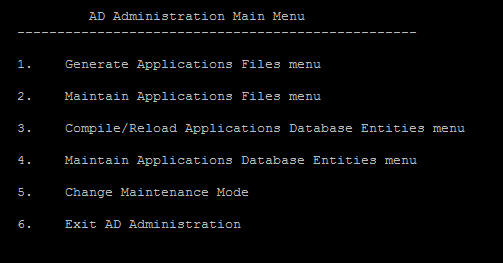
二、Generate Applications Files menu
1. Generate Applications Files menu
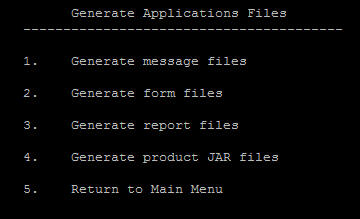
2.1. Generate message files
This task generates message binary files in the $PROD_TOP/mesg directory from oracle application object library tables.
We generally perform this task only when instructed to do so in a readme file of a patch.
2.2. Generate form files
(1). form
把$AU_TOP/forms/<LANG>/下的fmb文件生成<PROD>_TOP/forms/<LANG>下的fmx文件
(2). library
把$AU_TOP/resource/下的pll文件重新生成plx文件
(3). menu
把FNDMENU.mmb编译FNDMENU.mmx
2.3. Generate report files
根据安装语言生成report文件(.rdf)
2.4. Generate graphics files
This task generates Oracle graphics files for all installed languages.
Extension of the file name like (*.ogd),The serious of prompts and actions in this task are very similar to the prompts and actions in the Generate form files task.
2.5. Generate product JAR files
GenerateJava archive (JAR) files whenever you upgrade the Developer technology stack orwhen recommended by Oracle Support Services.
It signs JAR files (if on the Webserver) and does the following:
(1). Generates product JAR files in JAVA_TOP and copies them to APPL_TOP.
(2). Generates other Java-related files under APPL_TOP and JAVA_TOP.
(3). Recreates Java libraries (appsborg.zip and appsborg2.zip) under APPL_TOP andJAVA_TOP.
三、Maintain Applications Files menu
1. Maintain Applications Files主要是用于保持你的系统文件最新。比如,你需要拷贝文件从一个特定位置或者转换文件的字符集
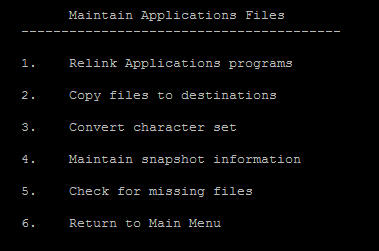
1. Relink Applications programs
Relinks Oracle Applications executable programs with the Oracle server libraries so that they function with the Oracle database.
For each product, choose whether to link all executables or only specific ones.
Note:The default is to relink without debug information.
Use the debug option only when requested to do so by Oracle Support Services.
2.2. Create Applications environment file
2.3. Copy files to destinations
Copies files from each product area to central locations where they can be easily referenced by non-Applications programs.
This option uses revision-based copy logic to ensure that the destination file versions are the same as, or higher than, the source file versions.
The file types and their respective destinations are shown in the following table:
These files: copied to (UNIX)
Java files $JAVA_TOP
HTML files $OAH_TOP
Media files $OAM_TOP
Note:When this option is used to copy reports or graphics files, the default destinationis under AU_TOP.
2.4.Convert character set
Preparesthe files in the APPL_TOP for conversion to another character set, and then performs the conversion.
When you choose this option, AD Administration presents another submenu, which contains options for scanning your files in preparation for the conversion.
The scan searches for exceptions — files that will have incomplete (lossy)conversions — so that you can fix potential problems before you actually convert the character set.
Choose one of the following scan options.
1. Scan the APPL_TOP for exceptions. Scans the APPL_TOP and creates three files in the admin\<SID>\out directory.
File Contents
admanifest_excp.lst Lists files that will not be converted because of lossy conversion. admanifest.lst Lists files thatcan be converted.
admanifest_lossy.lst Lists files with lossy conversions, including line by line detail.
Review the files listed in admanifest_excp.lst. Fix files that report lossy conversion before you convert the character set. Repeat this task until there are no entries in admanifest_excp.lst. If you need to see more detail, review admanifest_lossy.lst.
2. Scan a CUSTOM directory for exceptions. Collects the same information as the firsttask,but scans custom Applications directories rather than the APPL_TOPdirectory.
3. Convert character set. Run this task only if admanifest_excp.lst has no entries. Itprompts you for the manifest file (admanifest.lst) created when you ran the scan option(s).
The utility backs up the product source files and the APPL_TOP/admin source files. It saves product files in the <PROD>_TOP directories in the format<prod>_ s_<char_set>.zip. It saves admin source files in the APPL_TOP/admin directory in the format admin_s_<char_set>.zip
2.5. Maintain snapshot information
There are two types of snapshots: APPL_TOP snapshots and global snapshots.
An APPL_TOP snapshot lists patches and versions of files in the APPL_TOP.
A global snapshot lists patches and latest versions of files in the entire Applications system (that is, across all APPL_TOPs).
Both APPL_TOP snapshots and global snapshots may be either current view snapshots or named view snapshots.
A current view snapshot is created once and updated when appropriate to maintain a consistent view. A partial view snapshot allows you to synchronize only selected files from a current view. A named view snapshot is a copy of the current view snapshot at a particular time (not necessarily the latest current view snapshot) and is not updated.
Maintain Snapshot Information menu options :
■ List snapshots (stored in the system)
■ Update current view snapshot (full or partial APPL_TOP and global)
■ Create named snapshot (select a current view snapshot to copy and name)
■ Export snapshot to file (select one to export to a text file)
■ Import snapshot from (a text) file
■ Delete named snapshot (select a snapshot for deletion)
2.6. Check for missing files
Verifies that all files needed to run Oracle Applications for the current configuration are in the current APPL_TOP.
Choose this task if you suspect there are files missing in your APPL_TOP.
四、Compile/Reload Applications Database Entities menu
1. Compile/Reload Applications Database Entities menu:
编译或者重新加载数据库entities,可以使用“Compile/Reload Applications Database Entities”里的菜单项。
比如你上传了一个新的菜单项,或者打了一个更改flexfield设置的patch,可以运行菜单中相关项。
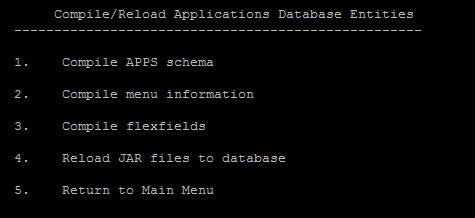
1. Compile APPS schema
Spawns parallel workers to compile invalid database objects in the APPS schema.
Note: The need for a separate MRC schema has been removed in this release, as has the associated prompt to run Invoker Rights.
2.2. Compile menu information
Compiles menu data structures.
Choose this task after you have uploaded menu entries to the FND_MENU_ENTRIES table, or if Compile Security concurrent requests submitted from the Menus form (after changing menu entries) fail for any reason.
AD Administration asks if you want to force compilation of all menus.
If you choose the default (No), only menus with changes are compiled. If you enter Yes, all menus are compiled.
Compiling all menus is generally not advised.
2.3. Compile flexfields
Compiles flexfield data structures in Oracle Application Object Library (FND) tables.
Choose this task after you apply a patch that changes the setup of flexfields.
Patches usually indicate when you should perform this step.
Flexfields automatically compile data when you use them for the first time, so running this task is not required.
However, compiling flexfield data at a specific time (for example, when system use is low), rather than automatically at first use, can alleviate potential runtime performance issues
2.4. Reload JAR files to database
Reloads all appropriate Oracle Applications JAR files into the database. Choose this task if all Oracle Applications Java classes are removed from your database.
for example, if the database Java Virtual Machine (JVM) is reloaded because of a corrupt database.
五、Maintain Applications Database Entities menu
1. Maintain Applications Database Entities menu
During normal system use, the integrity of your database can be compromised, for example through user error or after you apply a large patch.
It’s a good idea to verify the integrity of database entities as a regular maintenance procedure, or whenever the behavior of your system indicates that database entities may have been corrupted.
Some tasks on this menu report on issues, or potential issues, with database entities, and others actually remedy the issues.
Run these tasks only on the node where the core AD technology directories (the administration server) are located.
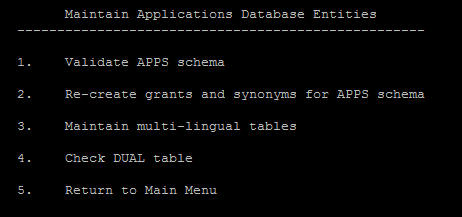
2.1. Validate APPS schema
Verifies the integrity of the APPS schema. It produces a report named <APPS schema name>.lst that lists issues and potential issues, grouped by the action required:
■ Issues you MUST fix (not specific to the APPS schema)
■ Issues you MUST fix (specific to the APPS schema)
■ Issues you may want to address (specific to the APPS schema).
The report is located in $APPL_TOP/admin/<SID>/out (UNIX), where <SID> is the value of the ORACLE_SID or TWO_TASK variable, or in %APPL_ TOP%\admin\<SID>\out (Windows),
where <SID> is the value of the LOCAL variable. Each section of the file contains instructions for resolving the issues that are listed. Most issues can be fixed by either compiling invalid database objects or recreating grants and synonyms.
2.2.Re-create grants and synonyms for APPS schema
This task recreates grants and synonyms for the Oracle Applications public schema (APPLSYSPUB), recreates grants on some packages from SYSTEM to APPS,
and spawns parallel workers to recreate grants and synonyms linking sequences and tables in the base schemas to the APPS schema.
Typically, you run this task after the Validate APPS schema task has reported issues with missing grants and synonyms.
3.Maintain multi-lingual tables
Run this task after you add a language. It prompts you for the number of workers, then updates all multilingual tables.
4.Check DUAL table
Some Oracle Applications products must access the DUAL table. It must exist in the SYS schema and contain exactly one row. This tasks verifies the existence of this table and the single row.
5.Maintain Multiple Reporting Currencies schema
It invokes PL/SQL packages which maintain database objects for these features. (See admntmls.pls and admntmcr.pls in $AD_TOP/admin/sql)
MRC and MLS are both implemented using "adjunct APPS schemas", meaning a complete copy of the objects in each APPS schema is replicated (and enhanced, in some cases) into an APPS_MRC and/or APPS_MLS schema. Whenever a change is made to an APPS schema, the modifications must be reflected in the adjunct schemas; otherwise, MRC and MLS functions may fail. This task is only displayed on the Database Objects menu if you have Multilingual (MLS) or Multiple Reporting Currency (MRC) functionality currently installed.
六、Change Maintenance Mode
1. Change Maintenance Mode
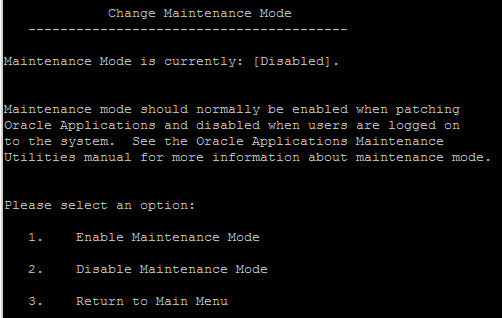
2.1.Enable Maintenance Mode
2.2.Disable Maintenance Mode
Thanks and Regards
学习笔记:朱龙春 - ERP DBA实践指南
技术交流,技术讨论,欢迎加入
Technology Blog Created By Oracle ERP - 鲍新建